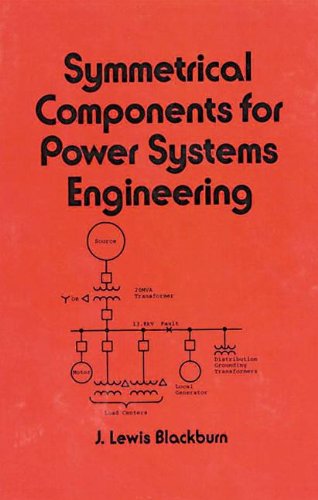Symmetrical Components for Power Systems Engineering ebook download
Par deshotel susan le lundi, septembre 14 2015, 23:20 - Lien permanent
Symmetrical Components for Power Systems Engineering. J. Lewis Blackburn

Symmetrical.Components.for.Power.Systems.Engineering.pdf
ISBN: 0824787676,9780824787677 | 448 pages | 12 Mb

Symmetrical Components for Power Systems Engineering J. Lewis Blackburn
Publisher: CRC Press
Learning symmetrical components can be overwhelming if you are considering its mathematical aspect only. Explore thousands of free applications across science, mathematics, engineering, technology, business, art, finance, social sciences, and more. The components of the power system by standard symbols rather than by their equivalent circuits. He is a co-author of two books on relaying: Computer Relaying for Power Systems, and Power Systems Relaying,. Calculate the three phase complex power using the original phasors and the Symmetrical Components and compare the two results. OPERATING PRINCIPLES AND RELAY CONSTRUCTIONS M.L. It is time to step back and understand this concept from a macro view. Chapter 7 Optional System Operation. DEPARTMENT OF ELECTRICAL/ELECTRONICS ENGINEERING SECOND SEMESTER EXAMINATION 2011/2012 SESSION What types of Buses are there in the Electrical Power System and what are their characteristics? Chakrabarti, 'A Text Book on Power System Engineering', Dhanpat Rai & Co., 1998. Chapter 8 Automatic Generation and Voltage Control. Symmetrical Components for Power Systems Engineering, Second Edition (Electrical and Computer Engineering) book download. Unbalanced load) and cases of faults in electric power systems (e.g. Mgu University S8 Electrical & electronics engineering Syllabus. Chapter 10 Symmetrical Components. Power System Model: Representation – Single Line Diagram – per unit system – per unit impedance diagram – network model formulation – bus admittance matrix – formation of Y bus and Z bus using singular transformation – symmetrical components – sequence impedance and networks. Principles and need for protective schemes – nature and causes of faults – types of faults – fault current calculation using symmetrical components – Power system earthing - Zones of protection and essential qualities of protection – Protection scheme. Using the theory of symmetrical components, it is easier to analyze the problems of unbalanced systems (e.g. 5.What is meant by impedance diagram. Chapter 11 Unsymmetrical Fault Analysis. Chapter 9 Symmetrical Fault Analysis.
Modern structural analysis: modelling process and guidance book download